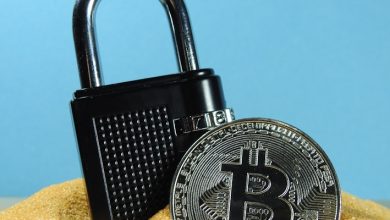A Guide to Setting Up Your First Hardware Wallet

- A Beginner’s Introduction to Hardware Wallets
- Choosing the Right Hardware Wallet for Your Needs
- Step-by-Step Guide to Setting Up Your Hardware Wallet
- Securing Your Cryptocurrency with a Hardware Wallet
- Tips for Safely Storing and Using Your Hardware Wallet
- Common Mistakes to Avoid When Using a Hardware Wallet
A Beginner’s Introduction to Hardware Wallets
When it comes to securing your cryptocurrency assets, hardware wallets are considered one of the safest options available. These physical devices store your private keys offline, making them less vulnerable to hacking and cyber attacks compared to online wallets.
Setting up a hardware wallet is relatively straightforward, even for beginners. Here’s an overview of what you need to know:
- Choose a reputable hardware wallet provider: Look for well-known brands such as Ledger or Trezor to ensure the security and reliability of your device.
- Buy the hardware wallet: Purchase your device from an authorized retailer to avoid counterfeit products that may compromise your funds.
- Set up the hardware wallet: Follow the manufacturer’s instructions to initialize your device and create a secure PIN code.
- Write down your recovery phrase: This is a series of words that will help you recover your funds if your hardware wallet is lost or damaged.
- Install the wallet software: Depending on the brand of your hardware wallet, you may need to download and install specific software to manage your cryptocurrency.
- Transfer your funds: Once your hardware wallet is set up, you can transfer your cryptocurrency assets from your exchange or online wallet to your hardware wallet for safekeeping.
Remember to keep your hardware wallet and recovery phrase in a secure location, such as a safe or lockbox, to prevent unauthorized access to your funds. By following these steps, you can enjoy peace of mind knowing that your cryptocurrency investments are protected by a hardware wallet.
Choosing the Right Hardware Wallet for Your Needs
When it comes to selecting the right hardware wallet for your specific requirements, there are several key factors to consider. The first thing to evaluate is the level of security offered by the wallet. Look for wallets that have strong encryption and two-factor authentication to ensure your funds are well-protected. Additionally, consider the supported cryptocurrencies and tokens, as well as the ease of use of the device.
Another crucial aspect to consider is the compatibility of the hardware wallet with different operating systems and platforms. Make sure that the wallet you choose is compatible with your computer or smartphone to avoid any compatibility issues. Furthermore, take into account the reputation and track record of the wallet manufacturer. Opt for a well-established and reputable company to minimize the risk of running into any issues with your hardware wallet in the future.
It is also important to look into the additional features offered by the hardware wallet, such as a user-friendly interface, backup and recovery options, and customer support. These features can make a significant difference in the overall user experience and convenience of using the wallet. Lastly, consider the price of the hardware wallet and compare it with other similar products on the market. While it is important to find a wallet that fits within your budget, prioritize security and features over cost to ensure the safety of your digital assets.
Step-by-Step Guide to Setting Up Your Hardware Wallet
Setting up your hardware wallet can be a straightforward process if you follow the step-by-step guide below:
- First, unpack your new hardware wallet and ensure that all the components are included in the box.
- Next, connect your hardware wallet to your computer or mobile device using the USB cable provided.
- Power on the hardware wallet by following the manufacturer’s instructions. This may involve pressing a button or entering a PIN code.
- Once the wallet is powered on, you will be prompted to set up a new wallet. Follow the on-screen instructions to choose a PIN code and write down your recovery seed phrase.
- It is crucial to keep your recovery seed phrase safe and secure, as it is the only way to access your funds if your hardware wallet is lost or damaged.
- After setting up your wallet, you can now install the necessary software on your computer or mobile device to manage your crypto assets.
- Use the software to connect your hardware wallet and transfer your cryptocurrencies to the wallet’s address.
- Double-check that your funds have been successfully transferred and that your hardware wallet is securely storing your assets.
- Finally, make sure to keep your hardware wallet and recovery seed phrase in a safe place, away from potential threats such as theft or damage.
Securing Your Cryptocurrency with a Hardware Wallet
When it comes to securing your cryptocurrency, a hardware wallet is one of the most secure options available. A hardware wallet is a physical device that stores your private keys offline, making it nearly impossible for hackers to access your funds remotely.
Setting up a hardware wallet is relatively easy and can provide you with peace of mind knowing that your digital assets are safe and secure. To get started, follow these steps:
- Choose a reputable hardware wallet provider such as Ledger or Trezor.
- Order your hardware wallet from the official website to ensure that you are getting a genuine product.
- Once your hardware wallet arrives, carefully read the instructions and set it up according to the manufacturer’s guidelines.
- Generate a strong passphrase and PIN code to add an extra layer of security to your device.
- Transfer your cryptocurrency from your exchange or software wallet to your hardware wallet.
By following these steps, you can rest assured that your cryptocurrency is safe from online threats and potential security breaches. Remember to keep your hardware wallet in a secure location and never share your private keys with anyone.
Tips for Safely Storing and Using Your Hardware Wallet
When it comes to safely storing and using your hardware wallet, there are a few important tips to keep in mind to ensure the security of your cryptocurrency assets.
- Always keep your hardware wallet in a secure location, such as a safe or a locked drawer, when not in use. This will help protect it from theft or physical damage.
- Make sure to set up a strong PIN code for your hardware wallet and never share it with anyone. This adds an extra layer of security in case your wallet falls into the wrong hands.
- Regularly update the firmware of your hardware wallet to ensure that it has the latest security features and bug fixes. This will help protect your assets from potential vulnerabilities.
- When using your hardware wallet to make transactions, always double-check the recipient address to ensure that you are sending your cryptocurrency to the intended destination. This will help prevent any accidental loss of funds.
- If you ever lose your hardware wallet or it gets stolen, make sure to have a backup of your recovery seed stored in a secure location. This will allow you to recover your funds onto a new hardware wallet if needed.
By following these tips, you can help ensure the safety and security of your cryptocurrency assets stored on your hardware wallet.
Common Mistakes to Avoid When Using a Hardware Wallet
When using a hardware wallet, it is important to be aware of common mistakes that can jeopardize the security of your cryptocurrency. By avoiding these pitfalls, you can ensure that your assets are safe and secure. Here are some key mistakes to steer clear of:
- Sharing your recovery seed phrase with anyone else. This is essentially giving them access to your funds, so keep it confidential.
- Entering your pin or seed phrase on a computer or device that may be compromised with malware. Always use a secure and trusted device.
- Not double-checking the recipient address before sending a transaction. Once a transaction is initiated, it cannot be reversed.
- Ignoring firmware updates for your hardware wallet. These updates often include important security patches.
- Storing your recovery seed phrase digitally or in a location that is not secure. Write it down on paper and store it in a safe place.
By being mindful of these common mistakes, you can better protect your cryptocurrency investments and enjoy peace of mind knowing that your assets are secure.



